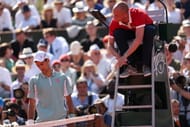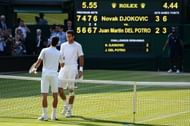So, what are the matches that still remain in your mind of the tennis year just gone by?
Do you remember Julien Benneteau being stranded at the net as Joao Sousa brilliantly passed him to save championship point at Kuala Lumpur? Do you recall the gigantic pair of John Isner and Kevin Anderson raining down aces in Atlanta in the tightest of 3-set, 0-break affairs? Or how about Janko Tipsarevic brushing off the inspired challenge of Bautista Agut in our very own Chennai Open?
The fact is, our concept of ‘best’ tennis matches goes beyond just two players performing at the peak of their abilities at the same time. It also tends to include the stage of the battle, and the stakes involved in the encounter. The more high profile the match and the more significant its outcome, the longer it is likely to remain in our collective memory. With this in mind, here are a few of the ‘best’ matches we were privileged to witness on the ATP tour over the last year, arranged in no particular order apart from the chronological. The focus is purely on singles here, so the odd, record-breaking 7-hour doubles classic played between a Switzerland and a Czech Republic in a Davis Cup tie does not make an appearance.
Novak Djokovic defeats Stanislas Wawrinka: 1-6, 7-5, 6-4, 6-7, 12-10
Australian Open, 4th round
Judged solely on the criterion of sustained quality of shot-making, this match has no equal this year. Djokovic’s rubber-band elastic shots combined with the brutally elegant groundstrokes of Wawrinka provided a scorcher of a start to the season.
The victory-from-the-brink act by Djokovic was something we have seen time and again from him over the years, and deep in the fifth set, it almost felt expected, at some level. What was less expected was the revelation in consistently aggressive strokeplay that came from Wawrinka.
This was the first indication of what was in store for the year from the lesser known Swiss. By the time the curtains came down on the season, Wawrinka would go on to have an unprecedented string of victories over top 10 opponents, play in the longest ever Davis Cup doubles match, make it to his debut ATP World Tour Finals, and generally impress everyone with his newly acquired status of elite contender. Djokovic, meanwhile, would calmly recover from this nail-biter of an encounter to secure his fourth Australian Open crown.
Rafael Nadal defeats Juan Martin del Potro: 4-6, 6-3, 6-4
Indian Wells, final
Both men brought interesting storylines into this match. Nadal was playing in his first hardcourt tournament since his return from a seven-month injury layoff. His results on clay, so far, had been encouraging, but this was his first true challenge, a real measure of the kind of player the world could expect to see in Rafa after his comeback.
Del Potro had made it to the final the hard way – beating Andy Murray and Novak Djokovic in succession over the last two rounds. He was playing inspired tennis, finally approaching the level which got him his US Open title a couple of years earlier. The question was, could he be the man to pull off the impossible feat of beating the Big 3 of men’s tennis in a row?
For the first half of the match, this actually seemed to be the case, as the Argentine went up by a set and a break. All the patterns of play he had used in his previous two matches were on full display, the lethal forehand, the newfound slice, and it seemed a matter of time before the del Potro juggernaut managed to stall the Nadal comeback.
But the famed fighting spirit of Nadal came to the fore in the nick of time, making everyone realize what they had been missing over the last seven months. He upped his aggression, his shots began to find the lines, and helped by a marginal drop in standard of play from del Potro, began to turn the match around. Soon, he was holding the trophy aloft, being congratulated by friend and tournament mentor Larry Ellison, and soaking in the joy of victory. We knew then that Nadal had well and truly returned to the tennis circuit. What we were yet to find out was just how successful his comeback season would be.
Rafael Nadal defeats Novak Djokovic: 6-4, 3-6, 6-1, 6-7, 9-7
French Open, semi-final
In the not-too-distant future, this match is likely to be remembered wrongly as the thrilling final of Roland Garros, 2013, with all due respect to David Ferrer and his maiden Grand Slam final appearance.
By this time in the season, Nadal was well in the middle of his comeback streak, and had established himself in his familiar, comfortable groove on clay. Djokovic, on the other hand, had publicly declared his target of acquiring the French Open title this year, and had also beaten Nadal in their recent encounter on clay, in Monte Carlo. Sparks were thus expected to fly in this encounter.
In one of those rare cases where a hyped-up encounter actually manages to exceed expectations, Nadal and Djokovic played a classic match which must rank among the top in their fabled rivalry. It had a bit of everything, from dramatic momentum shifts across the match, to familiar Djokovic Houdini acts in the fourth set, to sustained clay court brilliance from Nadal, to net collisions at critical junctures in the match.
The last of these, from Djokovic, when he was up a break in the fifth set, but unable to prevent contact with the net when the ball was in play, proved to be one of those small but significant moments on which the match hinged. By breaking Djokovic for the final time in the 16th game of the last set, Nadal managed to keep the Serb’s Rolland Garros challenge at bay for at least one more year, and also won the French Open for an unprecedented eighth time. After duly beating David Ferrer in the actual final, that is.
Novak Djokovic defeats Juan Martin del Potro: 7-5, 4-6, 7-6, 6-7, 6-3
Wimbledon, semi-final
The Tower of Tandil had slowly been building up a solid season so far, and the time seemed ripe to really stamp his presence on the year with a breakthrough performance. Such a performance, in del Potro’s case, could be nothing less than a significant victory over a Big 3 player on course to a Grand Slam title.
The opportunity seemed to present itself at Wimbledon when he played Djokovic in the semi-final, and for periods in the match, had him on the mat. It was a crazy Wimbledon, with injuries and shock upsets making headlines almost every day of the fortnight. Del Potro himself had suffered a nasty fall in his last round against Ferrer, and there was uncertainty on how his leg would hold up against the fleet-footed Djokovic.
In the event, it held up very well indeed, well enough to provide the Centre Court crowd with a match brimming with quality and drama. Del Potro brought his big guns into play consistently, while Djokovic did a masterful job of absorbing the punches and counterattacking whenever possible. As the momentum in the match fluctuated from side to side , the players brought their personalities to the fore as well. Images of del Potro and Djokovic discussing line calls between themselves, and del Potro egging the crowd along for support, remain lasting images of a spectacular match.
In the end, Djokovic managed to extricate himself from the situation as only he can, while del Potro was left to rue his lost opportunities again. At that time, even the valiant defeat had seemed like a positive step forward for the Argentine, but looking back now from the end of the season, it does seem more like one of the many occasions in the year when del Potro blew and blew with all his might, but couldn’t quite bring the house down.
Rafael Nadal defeats Novak Djokovic: 6-4, 3-6, 7-6
Rogers Cup, Montreal, semi-final
We were now entering the American fall hardcourt season, the time of year when Nadal has traditionally been at his weakest. But in this, his season of renaissance, would it be any different? He was up against Djokovic again, arguably the best current hardcourt player on the circuit. In spite of the red hot form that Nadal was showing at the moment, this one was again too close to call.
The match played true to form as well. Nadal began by using the extra aggressive strategy that he reserves for Djokovic on hardcourts. He played closer to the lines, took the ball early, and looked to kill whenever possible. It paid dividends in the form of the first set, but Djokovic quickly adjusted. Using his double-handed backhand in particular to telling effect, Djokovic stormed back to level the match. In the third set, the pressure mounted, with Nadal, at one point, drilling Djokovic at the net with a passing shot. The tension was high enough for Djokovic not to accept the offered apology immediately. But Nadal was slowly gaining the upper hand again. After putting Djokovic under pressure on a couple of his service games, Nadal rode the tide into the tie-breaker, and sealed a memorable victory.
The match would have immediate consequences in terms of the momentum that it allowed Nadal to take into the US Open, the one Grand Slam which the Spaniard has always declared to be his toughest. In New York this year, he would reach the final again, play Djokovic again, and win again. Only, this time, his victory would be, by far the expected outcome.
In an attempt to summarize these remarkable matches that defined this ATP season, it is interesting to note that Novak Djokovic figures in all but one of them. While he lost two of these matches to Nadal, he kept his stronghold secure against contenders in the other two matches. In the end, it might be an enduring aspect of this season that though Nadal might have effected the most inspiring comeback of the year, and Murray might have accomplished the most significant achievement, it is Djokovic who gave us the most captivating stories to remember in his attempts to cling on to the pinnacle of professional tennis.
How did Novak Djokovic meet Jelena Ristic? All about the most admired couples in tennis


